Physiotherapy: Treaty of Waitangi, Maori Health, and Healthcare Delivery in New Zealand
VerifiedAdded on 2023/06/11
|9
|2149
|237
AI Summary
This article discusses the Treaty of Waitangi, Maori Health, and Healthcare Delivery in New Zealand in relation to Physiotherapy. It covers the four cornerstones of Maori health, the three principles of the Treaty of Waitangi, and the implications of the Treaty of Waitangi on healthcare delivery in New Zealand. It also provides insights on how to accommodate cultural needs in your practice.
Contribute Materials
Your contribution can guide someone’s learning journey. Share your
documents today.
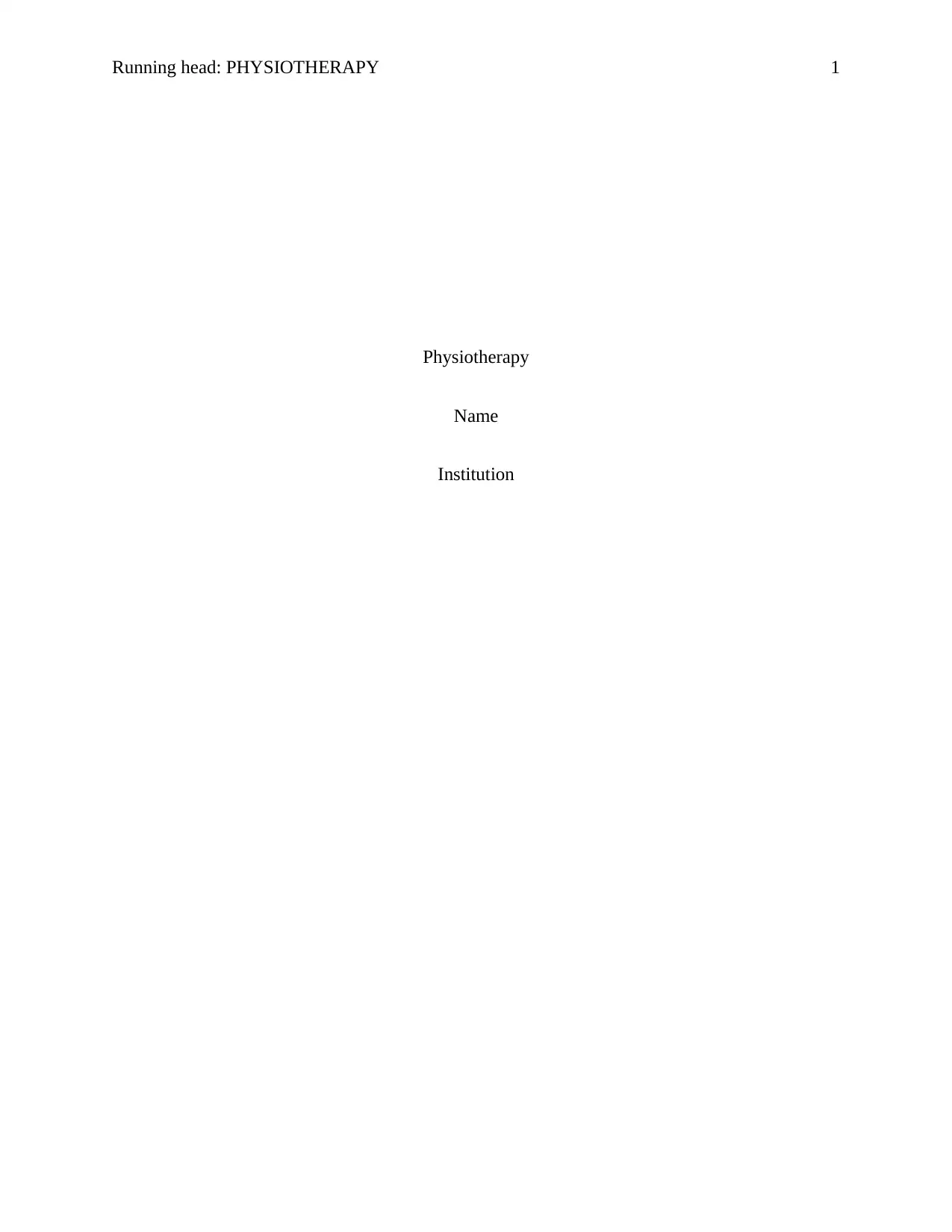
Running head: PHYSIOTHERAPY 1
Physiotherapy
Name
Institution
Physiotherapy
Name
Institution
Secure Best Marks with AI Grader
Need help grading? Try our AI Grader for instant feedback on your assignments.
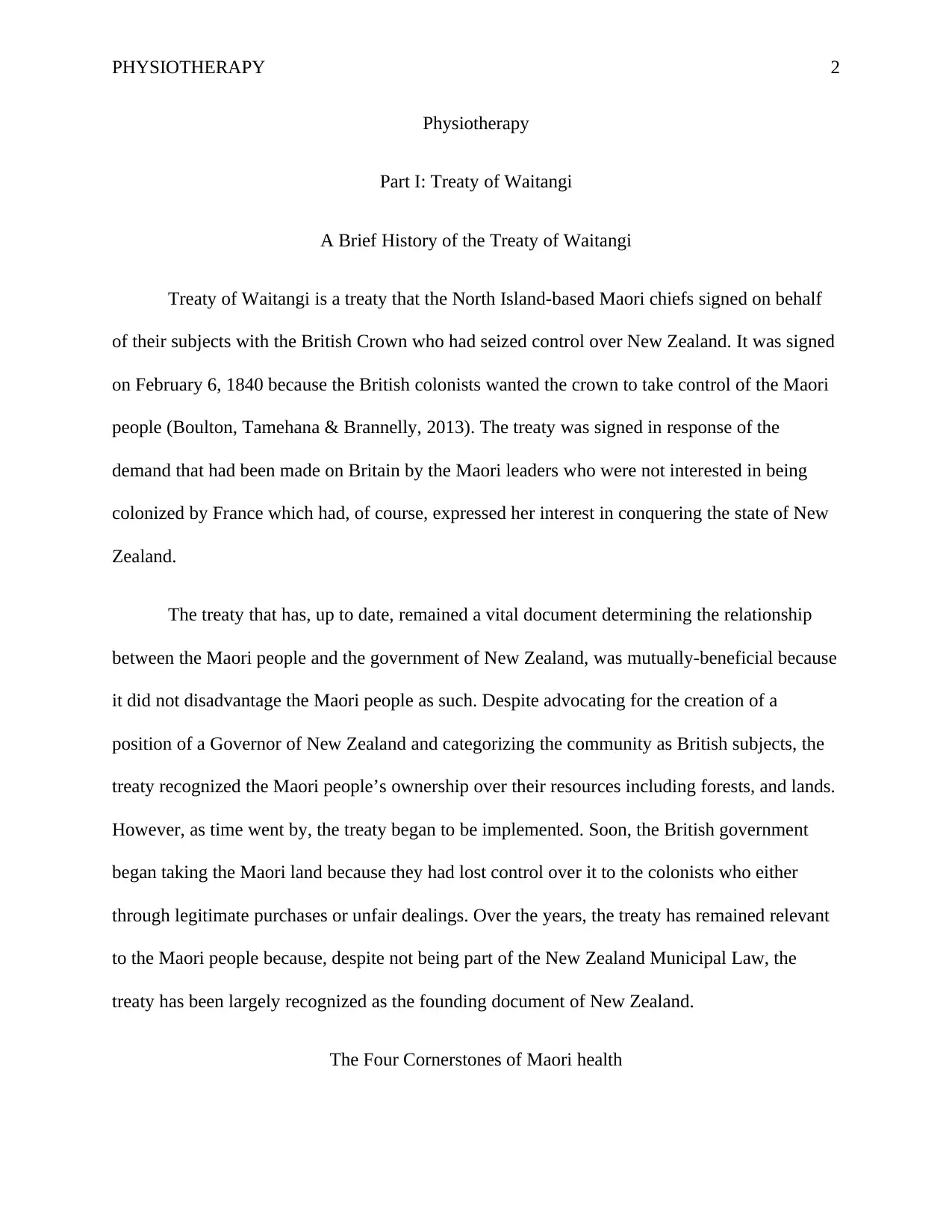
PHYSIOTHERAPY 2
Physiotherapy
Part I: Treaty of Waitangi
A Brief History of the Treaty of Waitangi
Treaty of Waitangi is a treaty that the North Island-based Maori chiefs signed on behalf
of their subjects with the British Crown who had seized control over New Zealand. It was signed
on February 6, 1840 because the British colonists wanted the crown to take control of the Maori
people (Boulton, Tamehana & Brannelly, 2013). The treaty was signed in response of the
demand that had been made on Britain by the Maori leaders who were not interested in being
colonized by France which had, of course, expressed her interest in conquering the state of New
Zealand.
The treaty that has, up to date, remained a vital document determining the relationship
between the Maori people and the government of New Zealand, was mutually-beneficial because
it did not disadvantage the Maori people as such. Despite advocating for the creation of a
position of a Governor of New Zealand and categorizing the community as British subjects, the
treaty recognized the Maori people’s ownership over their resources including forests, and lands.
However, as time went by, the treaty began to be implemented. Soon, the British government
began taking the Maori land because they had lost control over it to the colonists who either
through legitimate purchases or unfair dealings. Over the years, the treaty has remained relevant
to the Maori people because, despite not being part of the New Zealand Municipal Law, the
treaty has been largely recognized as the founding document of New Zealand.
The Four Cornerstones of Maori health
Physiotherapy
Part I: Treaty of Waitangi
A Brief History of the Treaty of Waitangi
Treaty of Waitangi is a treaty that the North Island-based Maori chiefs signed on behalf
of their subjects with the British Crown who had seized control over New Zealand. It was signed
on February 6, 1840 because the British colonists wanted the crown to take control of the Maori
people (Boulton, Tamehana & Brannelly, 2013). The treaty was signed in response of the
demand that had been made on Britain by the Maori leaders who were not interested in being
colonized by France which had, of course, expressed her interest in conquering the state of New
Zealand.
The treaty that has, up to date, remained a vital document determining the relationship
between the Maori people and the government of New Zealand, was mutually-beneficial because
it did not disadvantage the Maori people as such. Despite advocating for the creation of a
position of a Governor of New Zealand and categorizing the community as British subjects, the
treaty recognized the Maori people’s ownership over their resources including forests, and lands.
However, as time went by, the treaty began to be implemented. Soon, the British government
began taking the Maori land because they had lost control over it to the colonists who either
through legitimate purchases or unfair dealings. Over the years, the treaty has remained relevant
to the Maori people because, despite not being part of the New Zealand Municipal Law, the
treaty has been largely recognized as the founding document of New Zealand.
The Four Cornerstones of Maori health
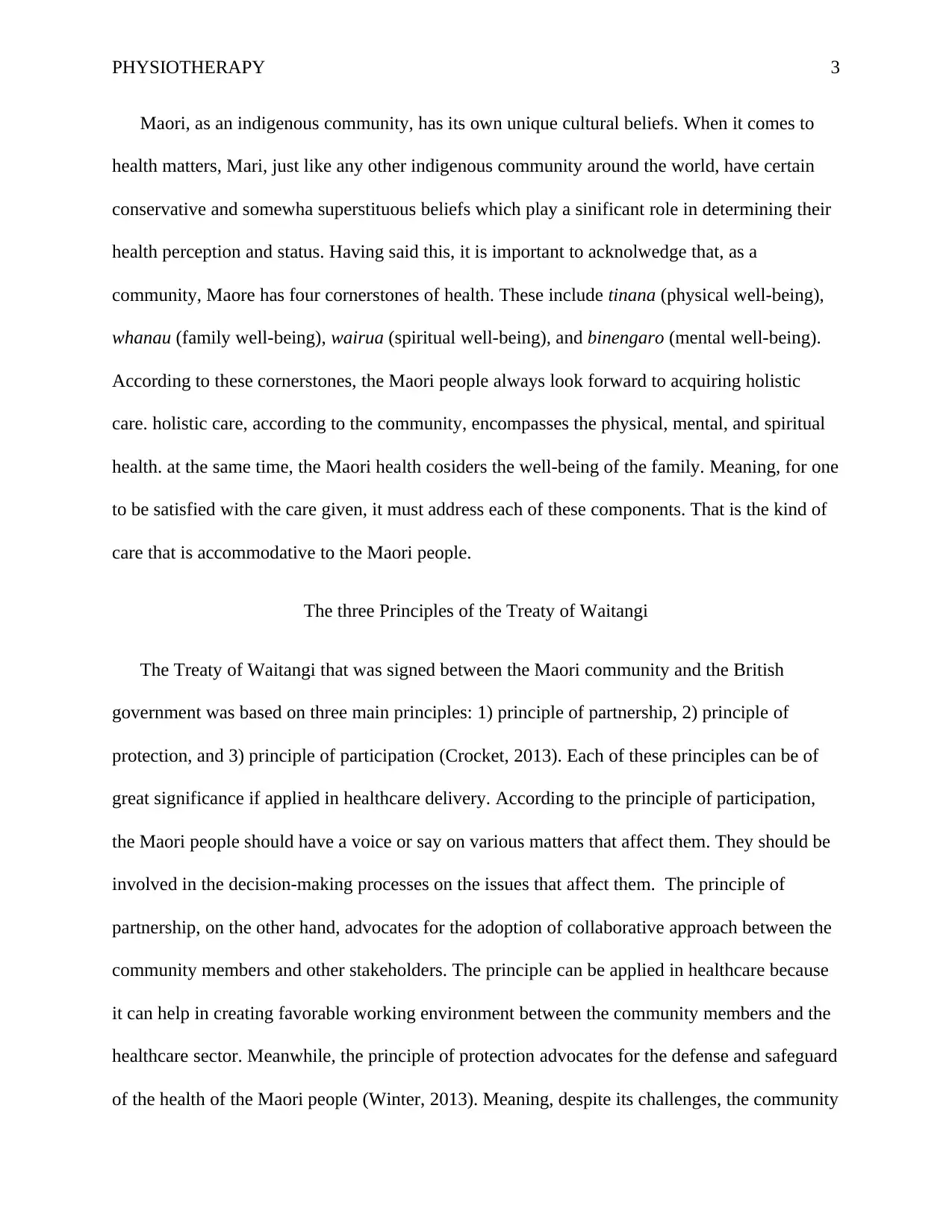
PHYSIOTHERAPY 3
Maori, as an indigenous community, has its own unique cultural beliefs. When it comes to
health matters, Mari, just like any other indigenous community around the world, have certain
conservative and somewha superstituous beliefs which play a sinificant role in determining their
health perception and status. Having said this, it is important to acknolwedge that, as a
community, Maore has four cornerstones of health. These include tinana (physical well-being),
whanau (family well-being), wairua (spiritual well-being), and binengaro (mental well-being).
According to these cornerstones, the Maori people always look forward to acquiring holistic
care. holistic care, according to the community, encompasses the physical, mental, and spiritual
health. at the same time, the Maori health cosiders the well-being of the family. Meaning, for one
to be satisfied with the care given, it must address each of these components. That is the kind of
care that is accommodative to the Maori people.
The three Principles of the Treaty of Waitangi
The Treaty of Waitangi that was signed between the Maori community and the British
government was based on three main principles: 1) principle of partnership, 2) principle of
protection, and 3) principle of participation (Crocket, 2013). Each of these principles can be of
great significance if applied in healthcare delivery. According to the principle of participation,
the Maori people should have a voice or say on various matters that affect them. They should be
involved in the decision-making processes on the issues that affect them. The principle of
partnership, on the other hand, advocates for the adoption of collaborative approach between the
community members and other stakeholders. The principle can be applied in healthcare because
it can help in creating favorable working environment between the community members and the
healthcare sector. Meanwhile, the principle of protection advocates for the defense and safeguard
of the health of the Maori people (Winter, 2013). Meaning, despite its challenges, the community
Maori, as an indigenous community, has its own unique cultural beliefs. When it comes to
health matters, Mari, just like any other indigenous community around the world, have certain
conservative and somewha superstituous beliefs which play a sinificant role in determining their
health perception and status. Having said this, it is important to acknolwedge that, as a
community, Maore has four cornerstones of health. These include tinana (physical well-being),
whanau (family well-being), wairua (spiritual well-being), and binengaro (mental well-being).
According to these cornerstones, the Maori people always look forward to acquiring holistic
care. holistic care, according to the community, encompasses the physical, mental, and spiritual
health. at the same time, the Maori health cosiders the well-being of the family. Meaning, for one
to be satisfied with the care given, it must address each of these components. That is the kind of
care that is accommodative to the Maori people.
The three Principles of the Treaty of Waitangi
The Treaty of Waitangi that was signed between the Maori community and the British
government was based on three main principles: 1) principle of partnership, 2) principle of
protection, and 3) principle of participation (Crocket, 2013). Each of these principles can be of
great significance if applied in healthcare delivery. According to the principle of participation,
the Maori people should have a voice or say on various matters that affect them. They should be
involved in the decision-making processes on the issues that affect them. The principle of
partnership, on the other hand, advocates for the adoption of collaborative approach between the
community members and other stakeholders. The principle can be applied in healthcare because
it can help in creating favorable working environment between the community members and the
healthcare sector. Meanwhile, the principle of protection advocates for the defense and safeguard
of the health of the Maori people (Winter, 2013). Meaning, despite its challenges, the community
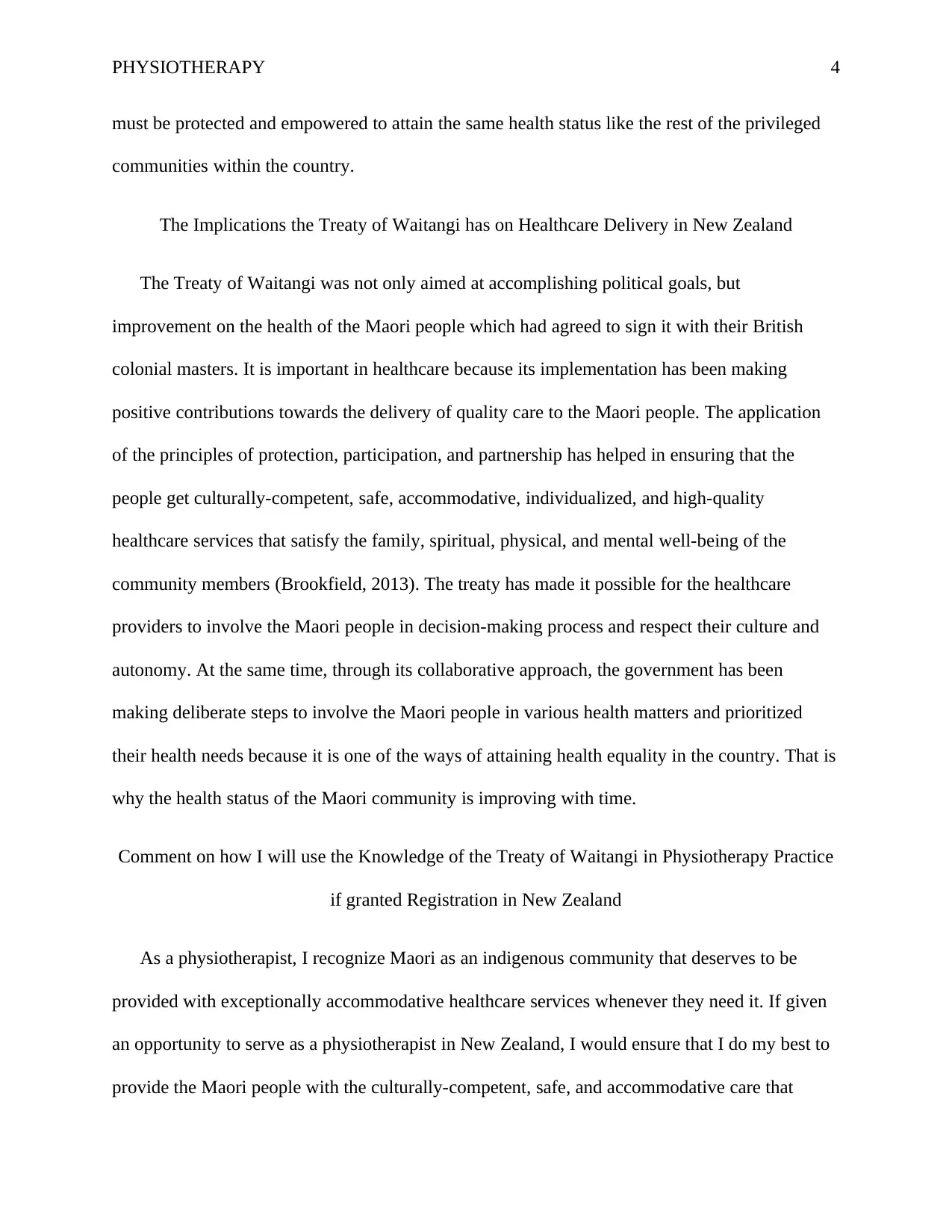
PHYSIOTHERAPY 4
must be protected and empowered to attain the same health status like the rest of the privileged
communities within the country.
The Implications the Treaty of Waitangi has on Healthcare Delivery in New Zealand
The Treaty of Waitangi was not only aimed at accomplishing political goals, but
improvement on the health of the Maori people which had agreed to sign it with their British
colonial masters. It is important in healthcare because its implementation has been making
positive contributions towards the delivery of quality care to the Maori people. The application
of the principles of protection, participation, and partnership has helped in ensuring that the
people get culturally-competent, safe, accommodative, individualized, and high-quality
healthcare services that satisfy the family, spiritual, physical, and mental well-being of the
community members (Brookfield, 2013). The treaty has made it possible for the healthcare
providers to involve the Maori people in decision-making process and respect their culture and
autonomy. At the same time, through its collaborative approach, the government has been
making deliberate steps to involve the Maori people in various health matters and prioritized
their health needs because it is one of the ways of attaining health equality in the country. That is
why the health status of the Maori community is improving with time.
Comment on how I will use the Knowledge of the Treaty of Waitangi in Physiotherapy Practice
if granted Registration in New Zealand
As a physiotherapist, I recognize Maori as an indigenous community that deserves to be
provided with exceptionally accommodative healthcare services whenever they need it. If given
an opportunity to serve as a physiotherapist in New Zealand, I would ensure that I do my best to
provide the Maori people with the culturally-competent, safe, and accommodative care that
must be protected and empowered to attain the same health status like the rest of the privileged
communities within the country.
The Implications the Treaty of Waitangi has on Healthcare Delivery in New Zealand
The Treaty of Waitangi was not only aimed at accomplishing political goals, but
improvement on the health of the Maori people which had agreed to sign it with their British
colonial masters. It is important in healthcare because its implementation has been making
positive contributions towards the delivery of quality care to the Maori people. The application
of the principles of protection, participation, and partnership has helped in ensuring that the
people get culturally-competent, safe, accommodative, individualized, and high-quality
healthcare services that satisfy the family, spiritual, physical, and mental well-being of the
community members (Brookfield, 2013). The treaty has made it possible for the healthcare
providers to involve the Maori people in decision-making process and respect their culture and
autonomy. At the same time, through its collaborative approach, the government has been
making deliberate steps to involve the Maori people in various health matters and prioritized
their health needs because it is one of the ways of attaining health equality in the country. That is
why the health status of the Maori community is improving with time.
Comment on how I will use the Knowledge of the Treaty of Waitangi in Physiotherapy Practice
if granted Registration in New Zealand
As a physiotherapist, I recognize Maori as an indigenous community that deserves to be
provided with exceptionally accommodative healthcare services whenever they need it. If given
an opportunity to serve as a physiotherapist in New Zealand, I would ensure that I do my best to
provide the Maori people with the culturally-competent, safe, and accommodative care that
Secure Best Marks with AI Grader
Need help grading? Try our AI Grader for instant feedback on your assignments.
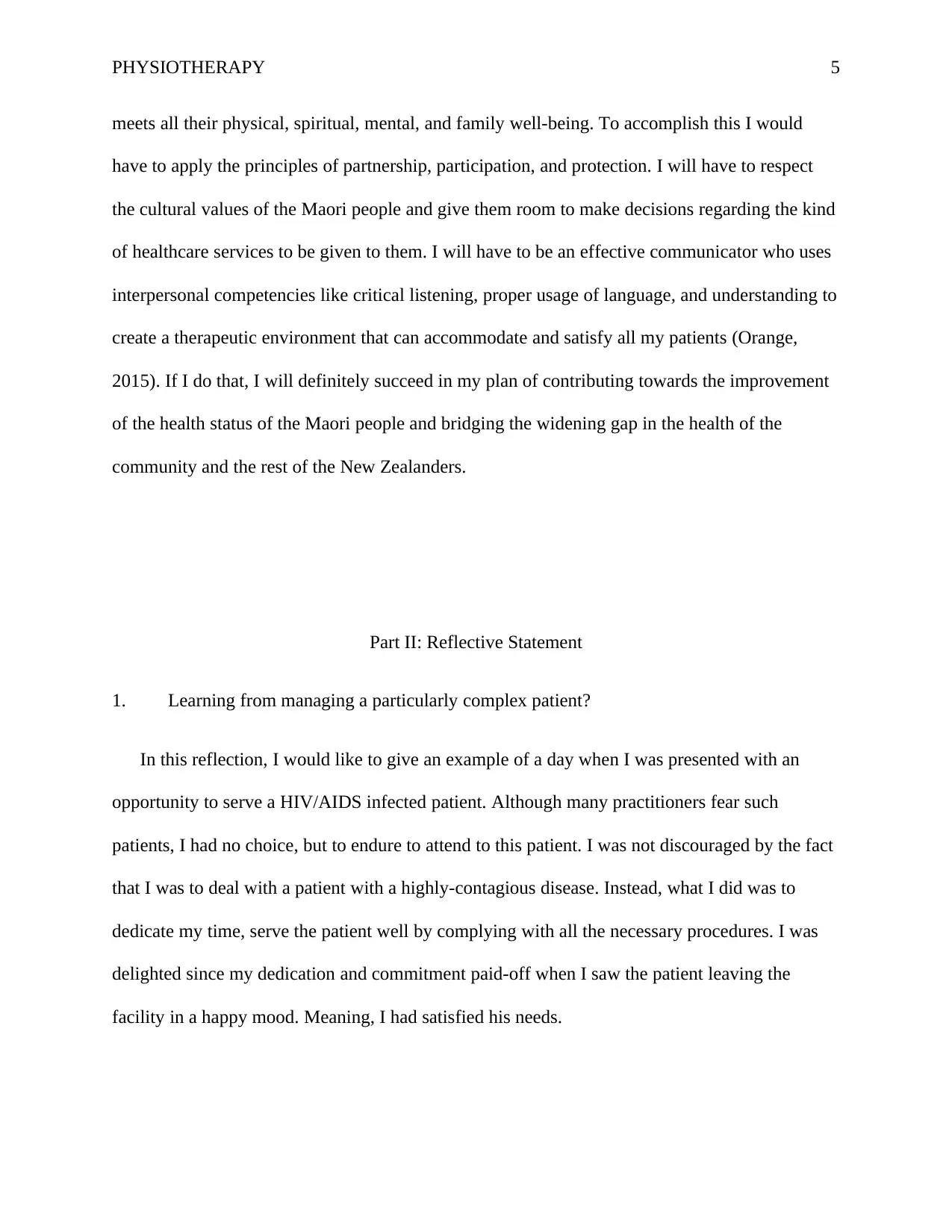
PHYSIOTHERAPY 5
meets all their physical, spiritual, mental, and family well-being. To accomplish this I would
have to apply the principles of partnership, participation, and protection. I will have to respect
the cultural values of the Maori people and give them room to make decisions regarding the kind
of healthcare services to be given to them. I will have to be an effective communicator who uses
interpersonal competencies like critical listening, proper usage of language, and understanding to
create a therapeutic environment that can accommodate and satisfy all my patients (Orange,
2015). If I do that, I will definitely succeed in my plan of contributing towards the improvement
of the health status of the Maori people and bridging the widening gap in the health of the
community and the rest of the New Zealanders.
Part II: Reflective Statement
1. Learning from managing a particularly complex patient?
In this reflection, I would like to give an example of a day when I was presented with an
opportunity to serve a HIV/AIDS infected patient. Although many practitioners fear such
patients, I had no choice, but to endure to attend to this patient. I was not discouraged by the fact
that I was to deal with a patient with a highly-contagious disease. Instead, what I did was to
dedicate my time, serve the patient well by complying with all the necessary procedures. I was
delighted since my dedication and commitment paid-off when I saw the patient leaving the
facility in a happy mood. Meaning, I had satisfied his needs.
meets all their physical, spiritual, mental, and family well-being. To accomplish this I would
have to apply the principles of partnership, participation, and protection. I will have to respect
the cultural values of the Maori people and give them room to make decisions regarding the kind
of healthcare services to be given to them. I will have to be an effective communicator who uses
interpersonal competencies like critical listening, proper usage of language, and understanding to
create a therapeutic environment that can accommodate and satisfy all my patients (Orange,
2015). If I do that, I will definitely succeed in my plan of contributing towards the improvement
of the health status of the Maori people and bridging the widening gap in the health of the
community and the rest of the New Zealanders.
Part II: Reflective Statement
1. Learning from managing a particularly complex patient?
In this reflection, I would like to give an example of a day when I was presented with an
opportunity to serve a HIV/AIDS infected patient. Although many practitioners fear such
patients, I had no choice, but to endure to attend to this patient. I was not discouraged by the fact
that I was to deal with a patient with a highly-contagious disease. Instead, what I did was to
dedicate my time, serve the patient well by complying with all the necessary procedures. I was
delighted since my dedication and commitment paid-off when I saw the patient leaving the
facility in a happy mood. Meaning, I had satisfied his needs.
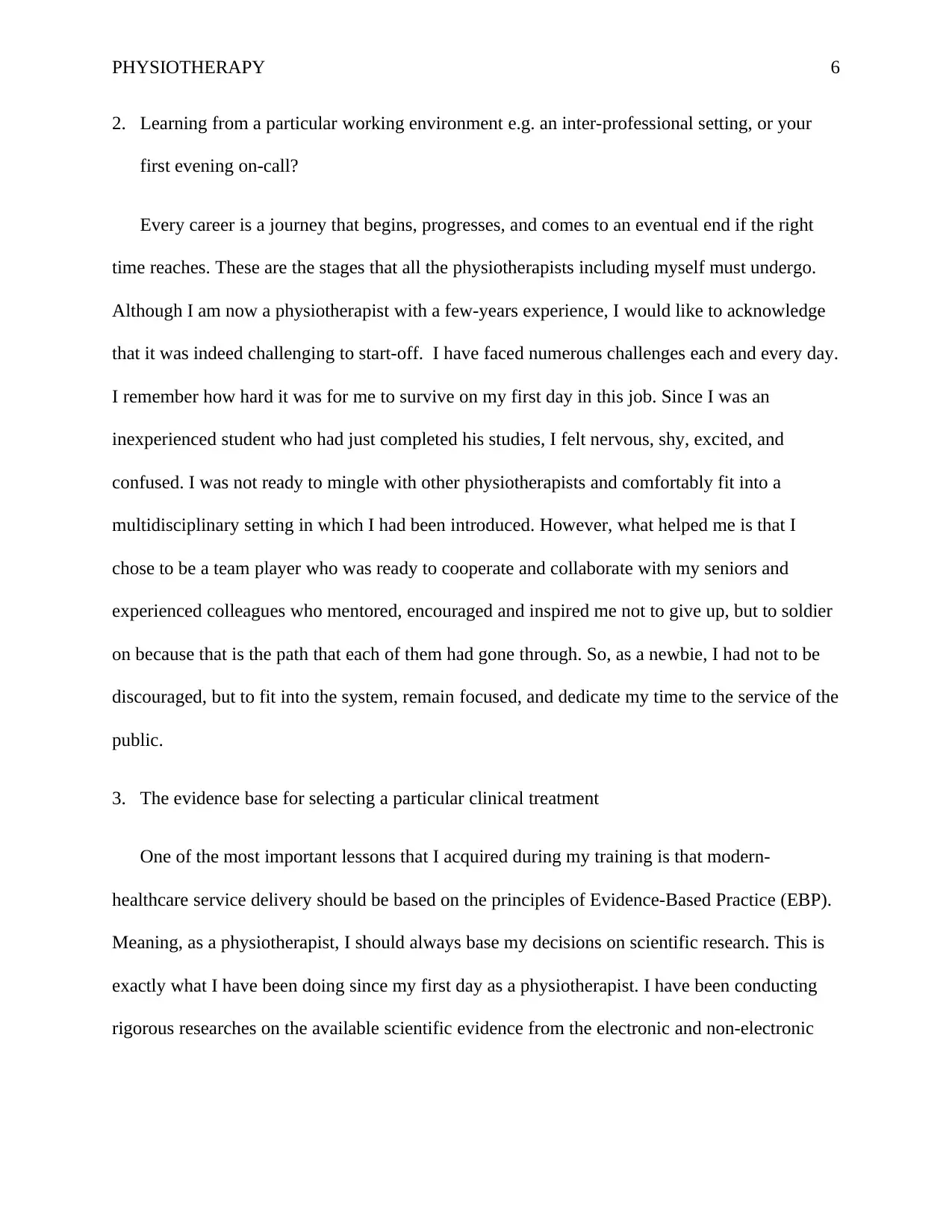
PHYSIOTHERAPY 6
2. Learning from a particular working environment e.g. an inter-professional setting, or your
first evening on-call?
Every career is a journey that begins, progresses, and comes to an eventual end if the right
time reaches. These are the stages that all the physiotherapists including myself must undergo.
Although I am now a physiotherapist with a few-years experience, I would like to acknowledge
that it was indeed challenging to start-off. I have faced numerous challenges each and every day.
I remember how hard it was for me to survive on my first day in this job. Since I was an
inexperienced student who had just completed his studies, I felt nervous, shy, excited, and
confused. I was not ready to mingle with other physiotherapists and comfortably fit into a
multidisciplinary setting in which I had been introduced. However, what helped me is that I
chose to be a team player who was ready to cooperate and collaborate with my seniors and
experienced colleagues who mentored, encouraged and inspired me not to give up, but to soldier
on because that is the path that each of them had gone through. So, as a newbie, I had not to be
discouraged, but to fit into the system, remain focused, and dedicate my time to the service of the
public.
3. The evidence base for selecting a particular clinical treatment
One of the most important lessons that I acquired during my training is that modern-
healthcare service delivery should be based on the principles of Evidence-Based Practice (EBP).
Meaning, as a physiotherapist, I should always base my decisions on scientific research. This is
exactly what I have been doing since my first day as a physiotherapist. I have been conducting
rigorous researches on the available scientific evidence from the electronic and non-electronic
2. Learning from a particular working environment e.g. an inter-professional setting, or your
first evening on-call?
Every career is a journey that begins, progresses, and comes to an eventual end if the right
time reaches. These are the stages that all the physiotherapists including myself must undergo.
Although I am now a physiotherapist with a few-years experience, I would like to acknowledge
that it was indeed challenging to start-off. I have faced numerous challenges each and every day.
I remember how hard it was for me to survive on my first day in this job. Since I was an
inexperienced student who had just completed his studies, I felt nervous, shy, excited, and
confused. I was not ready to mingle with other physiotherapists and comfortably fit into a
multidisciplinary setting in which I had been introduced. However, what helped me is that I
chose to be a team player who was ready to cooperate and collaborate with my seniors and
experienced colleagues who mentored, encouraged and inspired me not to give up, but to soldier
on because that is the path that each of them had gone through. So, as a newbie, I had not to be
discouraged, but to fit into the system, remain focused, and dedicate my time to the service of the
public.
3. The evidence base for selecting a particular clinical treatment
One of the most important lessons that I acquired during my training is that modern-
healthcare service delivery should be based on the principles of Evidence-Based Practice (EBP).
Meaning, as a physiotherapist, I should always base my decisions on scientific research. This is
exactly what I have been doing since my first day as a physiotherapist. I have been conducting
rigorous researches on the available scientific evidence from the electronic and non-electronic
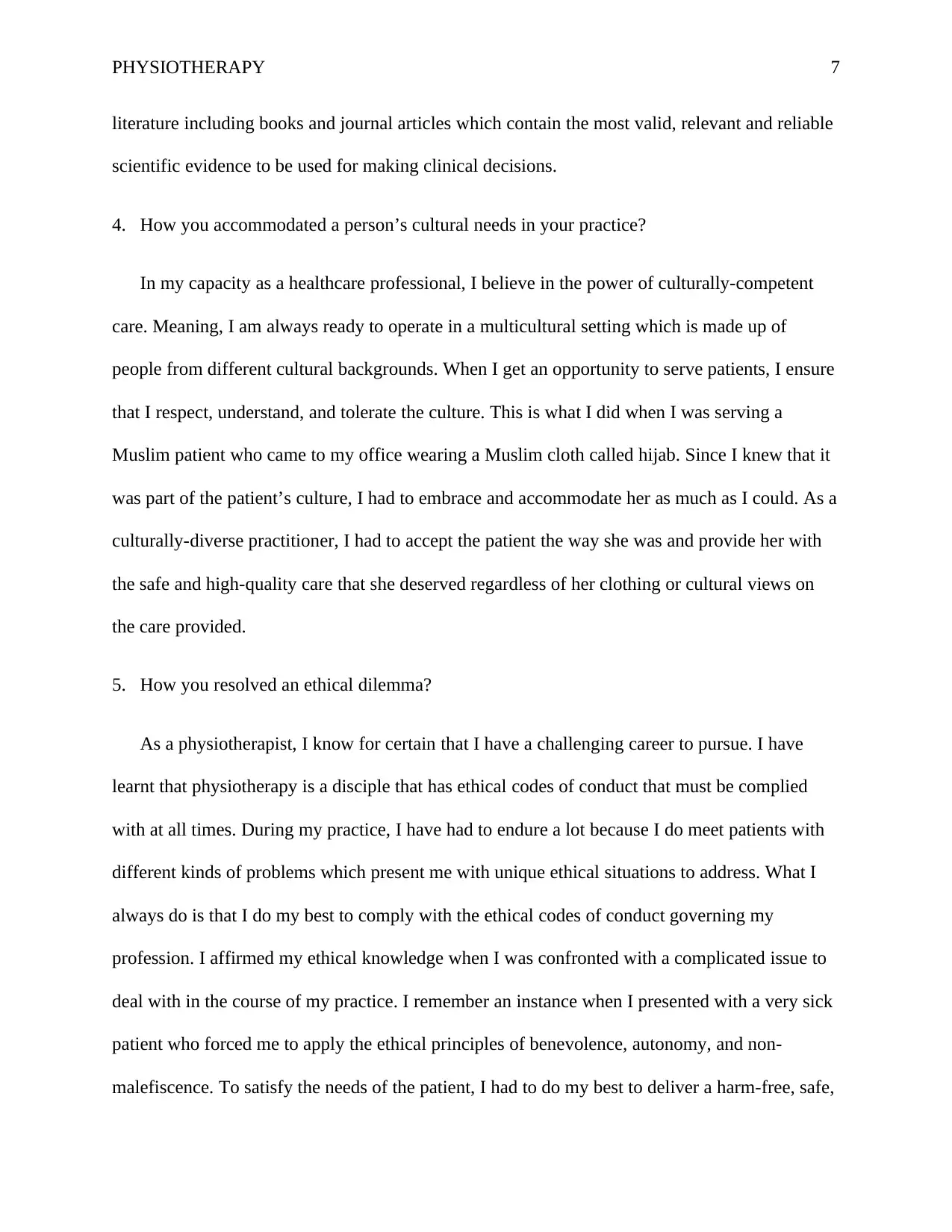
PHYSIOTHERAPY 7
literature including books and journal articles which contain the most valid, relevant and reliable
scientific evidence to be used for making clinical decisions.
4. How you accommodated a person’s cultural needs in your practice?
In my capacity as a healthcare professional, I believe in the power of culturally-competent
care. Meaning, I am always ready to operate in a multicultural setting which is made up of
people from different cultural backgrounds. When I get an opportunity to serve patients, I ensure
that I respect, understand, and tolerate the culture. This is what I did when I was serving a
Muslim patient who came to my office wearing a Muslim cloth called hijab. Since I knew that it
was part of the patient’s culture, I had to embrace and accommodate her as much as I could. As a
culturally-diverse practitioner, I had to accept the patient the way she was and provide her with
the safe and high-quality care that she deserved regardless of her clothing or cultural views on
the care provided.
5. How you resolved an ethical dilemma?
As a physiotherapist, I know for certain that I have a challenging career to pursue. I have
learnt that physiotherapy is a disciple that has ethical codes of conduct that must be complied
with at all times. During my practice, I have had to endure a lot because I do meet patients with
different kinds of problems which present me with unique ethical situations to address. What I
always do is that I do my best to comply with the ethical codes of conduct governing my
profession. I affirmed my ethical knowledge when I was confronted with a complicated issue to
deal with in the course of my practice. I remember an instance when I presented with a very sick
patient who forced me to apply the ethical principles of benevolence, autonomy, and non-
malefiscence. To satisfy the needs of the patient, I had to do my best to deliver a harm-free, safe,
literature including books and journal articles which contain the most valid, relevant and reliable
scientific evidence to be used for making clinical decisions.
4. How you accommodated a person’s cultural needs in your practice?
In my capacity as a healthcare professional, I believe in the power of culturally-competent
care. Meaning, I am always ready to operate in a multicultural setting which is made up of
people from different cultural backgrounds. When I get an opportunity to serve patients, I ensure
that I respect, understand, and tolerate the culture. This is what I did when I was serving a
Muslim patient who came to my office wearing a Muslim cloth called hijab. Since I knew that it
was part of the patient’s culture, I had to embrace and accommodate her as much as I could. As a
culturally-diverse practitioner, I had to accept the patient the way she was and provide her with
the safe and high-quality care that she deserved regardless of her clothing or cultural views on
the care provided.
5. How you resolved an ethical dilemma?
As a physiotherapist, I know for certain that I have a challenging career to pursue. I have
learnt that physiotherapy is a disciple that has ethical codes of conduct that must be complied
with at all times. During my practice, I have had to endure a lot because I do meet patients with
different kinds of problems which present me with unique ethical situations to address. What I
always do is that I do my best to comply with the ethical codes of conduct governing my
profession. I affirmed my ethical knowledge when I was confronted with a complicated issue to
deal with in the course of my practice. I remember an instance when I presented with a very sick
patient who forced me to apply the ethical principles of benevolence, autonomy, and non-
malefiscence. To satisfy the needs of the patient, I had to do my best to deliver a harm-free, safe,
Paraphrase This Document
Need a fresh take? Get an instant paraphrase of this document with our AI Paraphraser
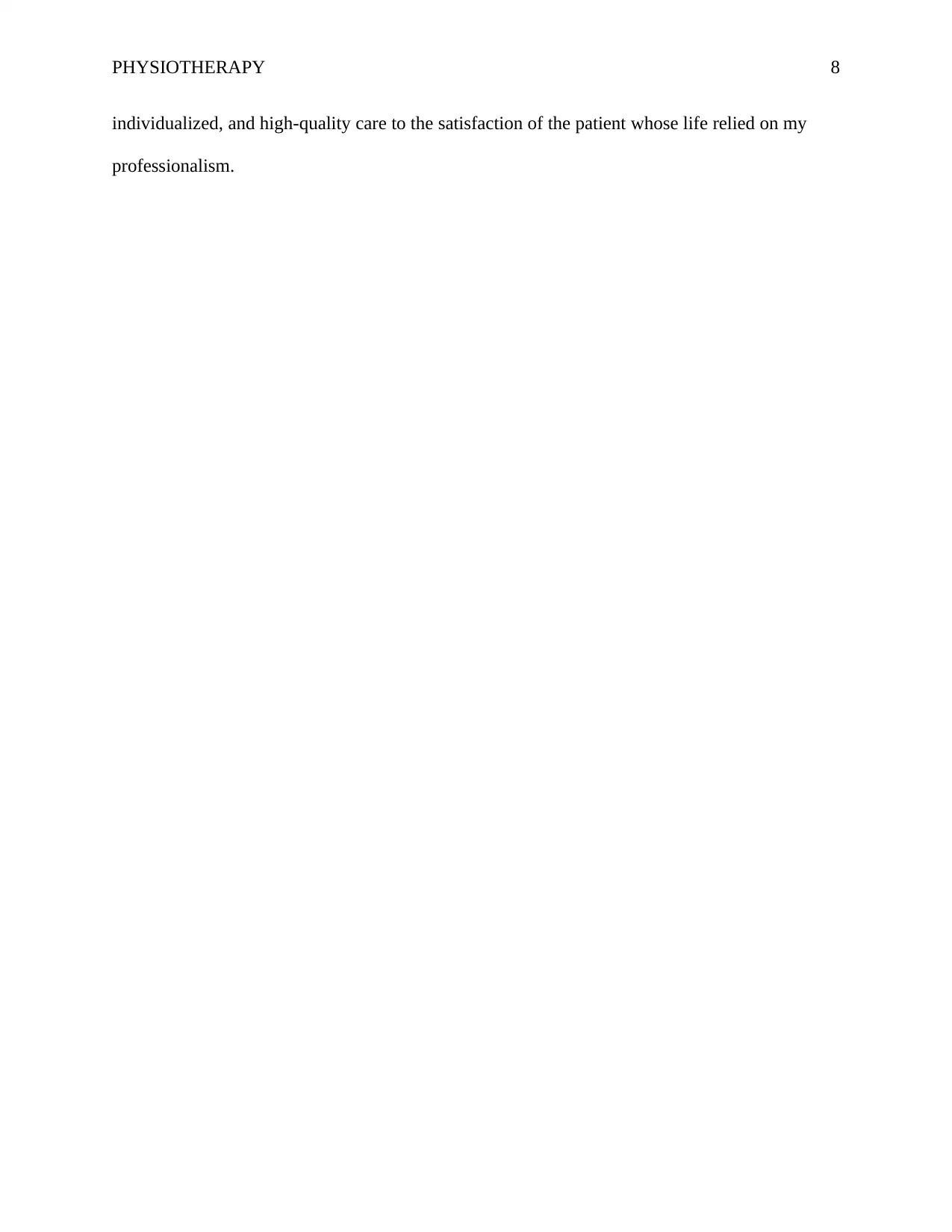
PHYSIOTHERAPY 8
individualized, and high-quality care to the satisfaction of the patient whose life relied on my
professionalism.
individualized, and high-quality care to the satisfaction of the patient whose life relied on my
professionalism.
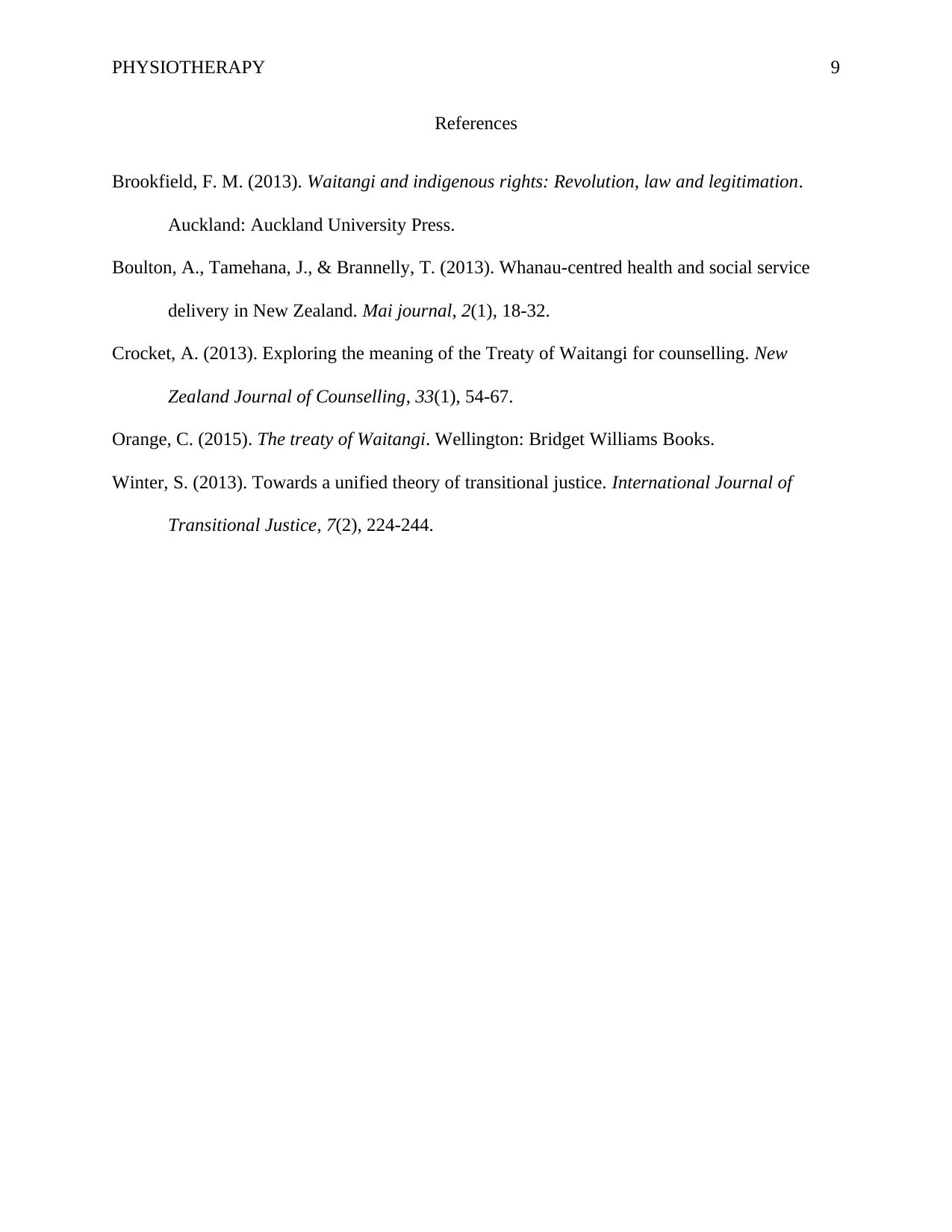
PHYSIOTHERAPY 9
References
Brookfield, F. M. (2013). Waitangi and indigenous rights: Revolution, law and legitimation.
Auckland: Auckland University Press.
Boulton, A., Tamehana, J., & Brannelly, T. (2013). Whanau-centred health and social service
delivery in New Zealand. Mai journal, 2(1), 18-32.
Crocket, A. (2013). Exploring the meaning of the Treaty of Waitangi for counselling. New
Zealand Journal of Counselling, 33(1), 54-67.
Orange, C. (2015). The treaty of Waitangi. Wellington: Bridget Williams Books.
Winter, S. (2013). Towards a unified theory of transitional justice. International Journal of
Transitional Justice, 7(2), 224-244.
References
Brookfield, F. M. (2013). Waitangi and indigenous rights: Revolution, law and legitimation.
Auckland: Auckland University Press.
Boulton, A., Tamehana, J., & Brannelly, T. (2013). Whanau-centred health and social service
delivery in New Zealand. Mai journal, 2(1), 18-32.
Crocket, A. (2013). Exploring the meaning of the Treaty of Waitangi for counselling. New
Zealand Journal of Counselling, 33(1), 54-67.
Orange, C. (2015). The treaty of Waitangi. Wellington: Bridget Williams Books.
Winter, S. (2013). Towards a unified theory of transitional justice. International Journal of
Transitional Justice, 7(2), 224-244.
1 out of 9
Related Documents
Your All-in-One AI-Powered Toolkit for Academic Success.
+13062052269
info@desklib.com
Available 24*7 on WhatsApp / Email
![[object Object]](/_next/static/media/star-bottom.7253800d.svg)
Unlock your academic potential
© 2024 | Zucol Services PVT LTD | All rights reserved.





